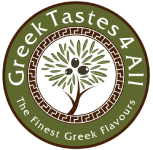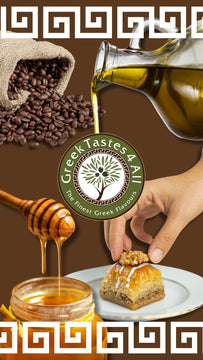Have Questions?Ask An Expert
Greek Mediterranean Orzotto, Traditional Orzo Pasta, Net 880g.
Trustify review stars will be displayed here!
-
Greek Mediterranean Orzotto, Traditional Orzo Pasta, Net weight 880g ( Pack of 4 boxes of 220g each ):
Traditional Mediterranean Orzotto is a food with very high nutritional value. Mostly is starch because it is made of semolina and durum flour. Pasta contains considerable amounts of minerals such as magnesium, iron, calcium, potassium, zinc, selenium and manganese. Also contains a small amount of sodium, and has no cholesterol, contains vitamin B, which includes folic acid and niacin. Eating orzo, especially when paired with other nutritious foods, might give you the energy boost you’ve been looking for. Our brains and bodies love using carbohydrates as fuel, of which there are plenty in orzo.
In the past, Greek villagers made pasta mostly in the summertime when they could dry it naturally. They would then keep it in the cellar of their homes and cook it in winter. It was thus a very convenient and easy food to prepare and a wonderful solution to feed a large and hungry family both economically and in a most nourishing way. The shape, size and cooking method of the Greek traditional pasta varies, depending on the region.
Though it looks a little like rice, orzo is actually a small pasta in the shape of rice! It's often used in Mediterranean diet recipes like Italian and Greek cuisine. In traditional Italian cooking, orzo is used in soups and broths, but it's also great as a side dish and in pasta salads. It's popular across Europe, particularly in Greece, where it's known as krithiraki. Quick and easy to prepare, with amazing taste and unlimited choices like vegetables, meat, fish or poultry to combine with.
Eating more pasta, including orzo, is a good way to keep you full longer. In 2009 the British Journal of Nutrition found that consumption of pasta may help you take in less food per day (Source: Livestrong).
Key Product Features:
i) Raw Ingredients, No Preservatives, Great Taste & High Nutritional Value.
ii) Though it looks a little like rice, orzo is actually a small pasta in the shape of rice! It's often used in Mediterranean diet recipes like Italian and Greek cuisine. In traditional Italian cooking, orzo is used in soups and broths, but it's also great as a side dish and in pasta salads. It's popular across Europe, particularly in Greece, where it's known as krithiraki.
iii) Quick and easy to prepare, with amazing taste and unlimited choices like vegetables, meat, fish or poultry to combine with.
iv) Eating orzo, especially when paired with other nutritious foods, might give you the energy boost you’ve been looking for. Our brains and bodies love using carbohydrates as fuel, of which there are plenty in orzo.
v) Pasta meals are central to the Greek Mediterranean Diet, with high nutritional value. Suitable for vegetarians.Storage Instructions: Store in a clean, dry and cool place. In a pan over medium heat add olive oil & Orzotto. Stir until the pasta is lightly toasted for 3 minutes, then add 400ml of broth. Cook, stirring periodically to prevent pasta from sticking to the pan until the broth has been absorbed, about 3 minutes. Repeat with another 400ml broth until the liquid has been absorbed, 5 minutes more. Test the doneness of the pasta. Remove the Orzotto pan from the heat and vigorously stir in the Parmesan cheese and butter. Season to taste.
-
Ingredients :
-
-
GreekOrzo from durum wheat semolina,
-
Sun-dried Tomatoes,
-
Onion,
-
Parsley,
-
Basil / Chives (Dried) ,
-
Salt.
-
-
-
Cultivation under the Integrated Management Crop system ISO 22000:2005 and AGRO 2-1, AGRO 2-2 certified. Cultivation area: Serres, from rich plains of Macedonia in northern Greece.
-
Greek Mediterranean Orzotto, Traditional Orzo Pasta, Net weight 880g ( Pack of 4 boxes of 220g each ):
Traditional Mediterranean Orzotto is a food with very high nutritional value. Mostly is starch because it is made of semolina and durum flour. Pasta contains considerable amounts of minerals such as magnesium, iron, calcium, potassium, zinc, selenium and manganese. Also contains a small amount of sodium, and has no cholesterol, contains vitamin B, which includes folic acid and niacin. Eating orzo, especially when paired with other nutritious foods, might give you the energy boost you’ve been looking for. Our brains and bodies love using carbohydrates as fuel, of which there are plenty in orzo.
In the past, Greek villagers made pasta mostly in the summertime when they could dry it naturally. They would then keep it in the cellar of their homes and cook it in winter. It was thus a very convenient and easy food to prepare and a wonderful solution to feed a large and hungry family both economically and in a most nourishing way. The shape, size and cooking method of the Greek traditional pasta varies, depending on the region.
Though it looks a little like rice, orzo is actually a small pasta in the shape of rice! It's often used in Mediterranean diet recipes like Italian and Greek cuisine. In traditional Italian cooking, orzo is used in soups and broths, but it's also great as a side dish and in pasta salads. It's popular across Europe, particularly in Greece, where it's known as krithiraki. Quick and easy to prepare, with amazing taste and unlimited choices like vegetables, meat, fish or poultry to combine with.
Eating more pasta, including orzo, is a good way to keep you full longer. In 2009 the British Journal of Nutrition found that consumption of pasta may help you take in less food per day (Source: Livestrong).
Key Product Features:
i) Raw Ingredients, No Preservatives, Great Taste & High Nutritional Value.
ii) Though it looks a little like rice, orzo is actually a small pasta in the shape of rice! It's often used in Mediterranean diet recipes like Italian and Greek cuisine. In traditional Italian cooking, orzo is used in soups and broths, but it's also great as a side dish and in pasta salads. It's popular across Europe, particularly in Greece, where it's known as krithiraki.
iii) Quick and easy to prepare, with amazing taste and unlimited choices like vegetables, meat, fish or poultry to combine with.
iv) Eating orzo, especially when paired with other nutritious foods, might give you the energy boost you’ve been looking for. Our brains and bodies love using carbohydrates as fuel, of which there are plenty in orzo.
v) Pasta meals are central to the Greek Mediterranean Diet, with high nutritional value. Suitable for vegetarians.Storage Instructions: Store in a clean, dry and cool place. In a pan over medium heat add olive oil & Orzotto. Stir until the pasta is lightly toasted for 3 minutes, then add 400ml of broth. Cook, stirring periodically to prevent pasta from sticking to the pan until the broth has been absorbed, about 3 minutes. Repeat with another 400ml broth until the liquid has been absorbed, 5 minutes more. Test the doneness of the pasta. Remove the Orzotto pan from the heat and vigorously stir in the Parmesan cheese and butter. Season to taste.
-
Ingredients :
-
-
GreekOrzo from durum wheat semolina,
-
Sun-dried Tomatoes,
-
Onion,
-
Parsley,
-
Basil / Chives (Dried) ,
-
Salt.
-
-
-
Cultivation under the Integrated Management Crop system ISO 22000:2005 and AGRO 2-1, AGRO 2-2 certified. Cultivation area: Serres, from rich plains of Macedonia in northern Greece.
RETURNS POLICY
Lorem ipsum dolor sit amet, consectetur adipiscing elit. Morbi ut blandit risus. Donec mollis nec tellus et rutrum. Orci varius natoque penatibus et magnis dis parturient montes, nascetur ridiculus mus. Ut consequat quam a purus faucibus scelerisque. Mauris ac dui ante. Pellentesque congue porttitor tempus. Donec sodales dapibus urna sed dictum. Duis congue posuere libero, a aliquam est porta quis.
Donec ullamcorper magna enim, vitae fermentum turpis elementum quis. Interdum et malesuada fames ac ante ipsum primis in faucibus.
Curabitur vel sem mi. Proin in lobortis ipsum. Aliquam rutrum tempor ex ac rutrum. Maecenas nunc nulla, placerat at eleifend in, viverra etos sem. Nam sagittis lacus metus, dignissim blandit magna euismod eget. Suspendisse a nisl lacus. Phasellus eget augue tincidunt, sollicitudin lectus sed, convallis desto. Pellentesque vitae dui lacinia, venenatis erat sit amet, fringilla felis. Nullam maximus nisi nec mi facilisis.
SHIPPING
Lorem ipsum dolor sit amet, consectetur adipiscing elit. Morbi ut blandit risus. Donec mollis nec tellus et rutrum. Orci varius natoque penatibus et magnis dis parturient montes, nascetur ridiculus mus. Ut consequat quam a purus faucibus scelerisque. Mauris ac dui ante. Pellentesque congue porttitor tempus. Donec sodales dapibus urna sed dictum. Duis congue posuere libero, a aliquam est porta quis.
Donec ullamcorper magna enim, vitae fermentum turpis elementum quis. Interdum et malesuada fames ac ante ipsum primis in faucibus.
Curabitur vel sem mi. Proin in lobortis ipsum. Aliquam rutrum tempor ex ac rutrum. Maecenas nunc nulla, placerat at eleifend in, viverra etos sem. Nam sagittis lacus metus, dignissim blandit magna euismod eget. Suspendisse a nisl lacus. Phasellus eget augue tincidunt, sollicitudin lectus sed, convallis desto. Pellentesque vitae dui lacinia, venenatis erat sit amet, fringilla felis. Nullam maximus nisi nec mi facilisis.



























